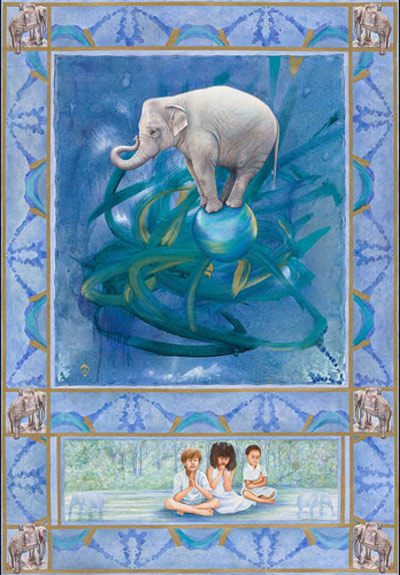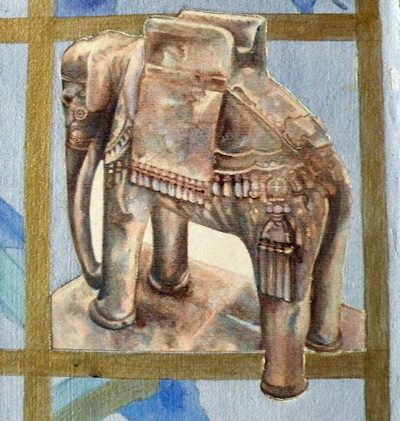Email: Calley@CalleyONeill.com
Giclee:
Small (approx. 19" x 24") $525
$525
Large (approx 24" x 36") $1000
$1000
Small Hand Embellished - $1000
Large Hand embellished - $2000
Rose's Dream
from The Rama Exhibition
 | ||||
The biggest, most powerful and one of the most beloved charismatic animals on Earth, Asian Elephants stand 7 to 12 feet tall and weigh between 6,000 and 15,000 pounds, reaching their maximum size at about 25 years old. From trunk to tail, they can be 30 feet. They achieve this by spending as much as 18 – 20 hours a day feeding. They are known as a keystone species, one that plays a critical role in maintaining the structure of an ecological community and whose contribution to the community is vital in maintaining its health and balance. Elephants
- keep the savannas and grasslands from turning into forests.
- They provide water holes for other species in dry riverbeds.
- They spread seeds.
- They make paths, which act as firebreaks and rainwater conduits, and
- the disturbance they make provides amphibians, reptiles and insects for the birds to eat.
In cultures around the world, elephants have long been beloved animals, symbolic of wisdom, peace and power. In 1879, the Elephants Preservation Act was passed in India, protecting all elephants from harm, with the sole exception of a person’s self defense. This act honored the service that elephants have provided to humankind over many centuries. Elephants are revered for their memory, high intelligence, sonic communication over great distances, and complex social and emotional behaviors, including grief, compassion, tolerance and social openness, altruism, and self-awareness. Elephants never forget.
Elephants actually respond favorably to agriculture, logging and bamboo harvest if they are done at a sustainable yield level and the early successional forest is preserved, thus elephants are compatible with long-term sustainable use of forests.
Asian Elephants are at a high risk of extinction in the wild, and in a much more precarious situation than African elephants. Their primary threats are from conflicts with humans, primarily severe loss of habitat from development, population growth and the expansion of agriculture, especially palm oil plantations, which creates serious conflicts with farmers. The males are poached for their tusks.
They live in five Biodiversity Hotspots: Himalaya, Indo-Burma, Mountains of Southwest China, Sundaland, Western Ghats and Sri Lanka.
Art and Soul for the Earth
Big Island of Hawai'i







